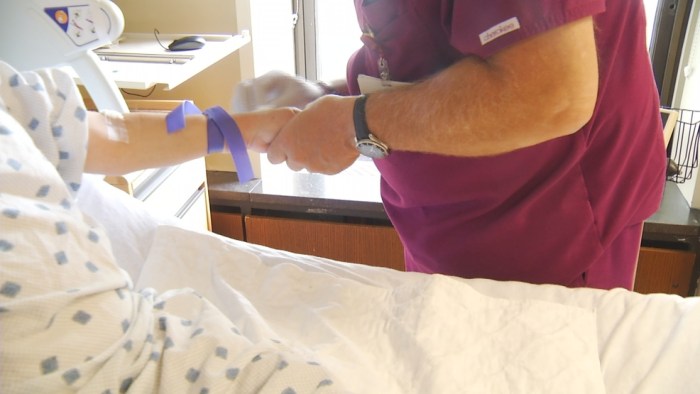A nurse is discontinuing a peripheral IV catheter, a procedure that requires meticulous care and precision. This comprehensive guide will delve into the essential steps, potential complications, and best practices associated with this common nursing intervention.
Understanding the indications for IV discontinuation, assessing the patient’s condition, and gathering the necessary equipment are crucial preparatory measures. The procedure itself involves removing the tape and dressing, clamping the IV tubing, withdrawing the catheter, and applying pressure to the insertion site.
Post-procedure care includes monitoring the insertion site, providing pain relief, and educating the patient on proper wound care.
Patient Assessment

Assessing the patient’s condition before discontinuing the IV catheter is crucial to ensure their safety and well-being.
Vital Signs and Parameters to Monitor
- Temperature
- Pulse
- Respiratory rate
- Blood pressure
- Oxygen saturation
- Skin color and temperature at the insertion site
Potential Complications and How to Address Them
- Infiltration:Leakage of IV fluid into surrounding tissue. Address by stopping infusion, elevating the limb, and applying warm compresses.
- Extravasation:Leakage of medication or fluid outside the vein. Address by stopping infusion, elevating the limb, and applying ice.
- Infection:Redness, swelling, pain, or discharge at the insertion site. Address by removing the catheter, culturing the site, and administering antibiotics.
Equipment Preparation
The following equipment is required for discontinuing an IV catheter:
Necessary Equipment and Supplies
- Alcohol swabs
- Gauze pads
- Tape
- Scissors
- IV catheter clamp
- Sharps container
Purpose and Function of Each Item
- Alcohol swabs:To clean the insertion site and prevent infection.
- Gauze pads:To absorb blood or fluid during removal.
- Tape:To secure the dressing over the insertion site.
- Scissors:To cut the IV tubing.
- IV catheter clamp:To stop the flow of fluid before withdrawing the catheter.
- Sharps container:To safely dispose of the catheter and needle.
Assembly and Preparation
- Gather all necessary equipment.
- Clean the insertion site with an alcohol swab.
- Apply a gauze pad over the insertion site.
- Clamp the IV tubing.
Procedure

Step-by-Step Discontinuation
- Remove the tape and dressing:Gently remove the tape and dressing covering the insertion site.
- Clamp the IV tubing:Close the IV catheter clamp to stop the flow of fluid.
- Withdraw the catheter:Grasp the catheter hub and gently pull it straight out from the vein.
- Apply pressure to the insertion site:Apply firm pressure to the insertion site with a gauze pad for several minutes to stop any bleeding.
Post-Procedure Care

Monitoring the patient after discontinuing the IV catheter is essential to ensure their safety and comfort.
Assessment and Intervention, A nurse is discontinuing a peripheral iv catheter
- Assess the insertion site:Inspect the insertion site for signs of infection or bleeding.
- Provide pain relief:Offer pain medication or comfort measures as needed.
- Educate the patient:Instruct the patient on proper wound care and activity restrictions.
Documentation

Documenting the discontinuation of the IV catheter is crucial for patient safety and record-keeping.
Information to Include
- Date and time of discontinuation
- Patient’s name and medical record number
- Reason for discontinuation
- Type and size of IV catheter
- Insertion site
- Condition of the insertion site
- Any complications or interventions
Purpose and Use
- Patient safety:Provides a record of the procedure for future reference.
- Quality assurance:Allows for monitoring of IV catheter care and outcomes.
- Legal protection:Documents the nurse’s actions and decisions.
Troubleshooting
Potential Problems and Solutions
- Unable to remove the catheter:Apply gentle traction and try again. If unsuccessful, contact a physician.
- Excessive bleeding:Apply firm pressure to the insertion site for several minutes. If bleeding persists, contact a physician.
- Infiltration or extravasation:Stop the infusion and elevate the limb. Apply warm or cold compresses as appropriate. Contact a physician.
Infection Control: A Nurse Is Discontinuing A Peripheral Iv Catheter
Maintaining infection control is paramount when discontinuing an IV catheter.
Infection Control Measures
- Maintain a sterile environment:Use clean equipment and aseptic technique.
- Dispose of contaminated materials:Place used materials in a sharps container.
- Prevent the spread of infection:Wash hands thoroughly before and after the procedure.
Education
Educating the patient about IV catheter discontinuation is essential for their well-being.
Patient Education
- Procedure explanation:Explain the steps involved in discontinuing the IV catheter.
- Answering questions:Address the patient’s questions and concerns.
- Empowering the patient:Encourage the patient to participate in their own care.
Commonly Asked Questions
What are the indications for discontinuing an IV catheter?
IV catheters are typically discontinued when the IV therapy is no longer needed, when the catheter becomes dislodged or damaged, or when there are signs of infection or complications.
What are the potential complications of IV catheter discontinuation?
Potential complications include bleeding, infection, hematoma, and air embolism. Proper technique and adherence to infection control protocols can minimize these risks.
How can I prevent infection when discontinuing an IV catheter?
Maintaining a sterile environment, using sterile technique, and disposing of contaminated materials properly are essential for preventing infection.